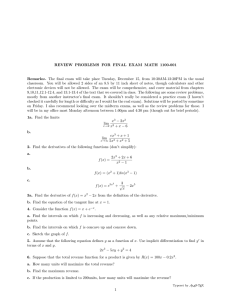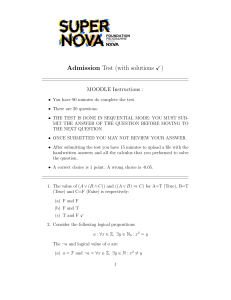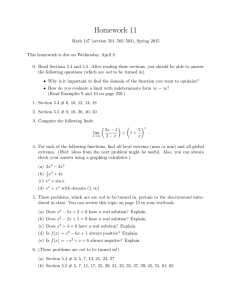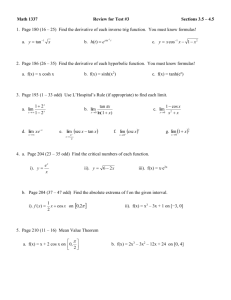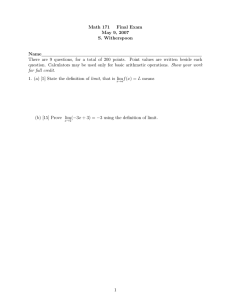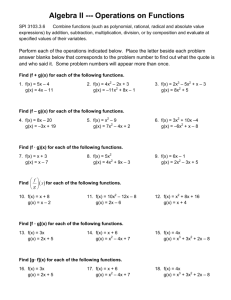Review Problems for Exam 1 Math 1100-4 Tuesday, February 7, 2012 Examples
advertisement
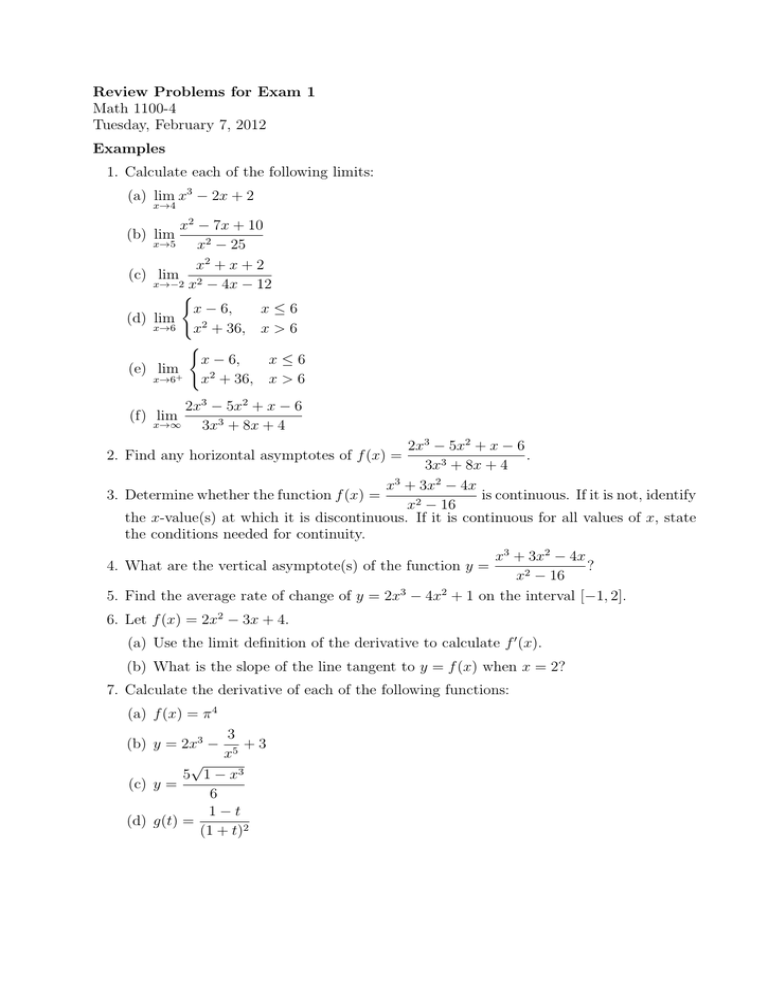
Review Problems for Exam 1 Math 1100-4 Tuesday, February 7, 2012 Examples 1. Calculate each of the following limits: (a) lim x3 − 2x + 2 x→4 x2 − 7x + 10 x→5 x2 − 25 x2 + x + 2 (c) lim 2 x→−2 x − 4x − 12 ( x − 6, x≤6 (d) lim 2 x→6 x + 36, x > 6 ( x − 6, x≤6 (e) lim+ 2 x→6 x + 36, x > 6 (b) lim 2x3 − 5x2 + x − 6 x→∞ 3x3 + 8x + 4 (f) lim 2x3 − 5x2 + x − 6 . 3x3 + 8x + 4 x3 + 3x2 − 4x 3. Determine whether the function f (x) = is continuous. If it is not, identify x2 − 16 the x-value(s) at which it is discontinuous. If it is continuous for all values of x, state the conditions needed for continuity. 2. Find any horizontal asymptotes of f (x) = x3 + 3x2 − 4x ? x2 − 16 5. Find the average rate of change of y = 2x3 − 4x2 + 1 on the interval [−1, 2]. 4. What are the vertical asymptote(s) of the function y = 6. Let f (x) = 2x2 − 3x + 4. (a) Use the limit definition of the derivative to calculate f 0 (x). (b) What is the slope of the line tangent to y = f (x) when x = 2? 7. Calculate the derivative of each of the following functions: (a) f (x) = π 4 3 (b) y = 2x3 − 5 + 3 x √ 5 1 − x3 (c) y = 6 1−t (d) g(t) = (1 + t)2 (e) h(z) = (z + 1)2 (z 2 − z + 2)3 2 with respect to x when x = 3? x 9. Calculate the indicated higher-order derivative of each of the following functions: 4 (a) f 00 (x) if f (x) = 2x7 − 5 x 3 dy (b) if y = (2x − 6)5 dx3 10. Suppose that the total profit function for a commodity is P (x) = 22x − 0.001x2 − 7, where P is the profit in dollars when x units are sold. 8. What is the instantaneous rate of change of y = x2 + (a) Find the marginal profit function. (b) Calculate the marginal profit when x = 10. What does this predict about the sale of the next unit? (c) Calculate P (11) − P (10). What does this represent? (d) What is the rate of change of the marginal profit when 10 units are sold? 11. Let y = 2x3 − 3x2 − 1 (a) Find the y-intercept of the function. (b) Find the critical value(s) of the function. (c) Where is the function increasing? Where is it decreasing? (d) Find the relative maxima and minima of y. Be sure to justify your answer with either the First Derivative Test or the Second Derivative Test. (e) Where is the graph of y concave up? Where is it concave down? What are its point(s) of inflection? (f) Using the information found in the previous parts of this question, sketch the graph of y = 2x3 − 3x2 − 1.
